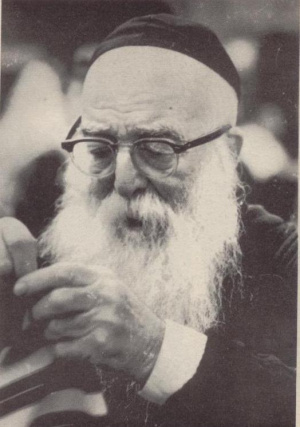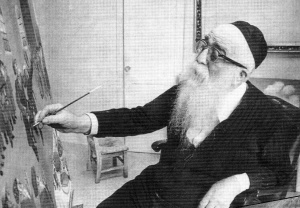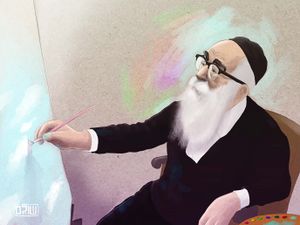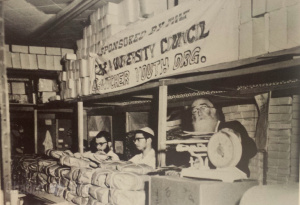Chanoch Hendel Futerfas




Reb Chanoch Hendel Futerfas (also known as Hendel Lieberman), (13 Nissan 5661 - 13 Adar II 5736) was a Chassidic artist who merited to be close to the family of Chabad Rebbes. His paintings mainly documented Chassidic life in the shtetl.
Life History[edit | edit source]
Born on 13 Nissan 5661 in the town of Pleshnitz to his father Reb Menachem Mendel Futerfas. His brother was the mashpia Reb Menachem Mendel Futerfas. Reb Hendel was also the great-nephew of Reb Chanoch Hendel Kugel, who was close to our Rebbes and a mashpia for the students of Tomchei Tmimim Lubavitch. It is believed that Reb Hendel Lieberman was named after this Reb Hendel who passed away one year before his birth.
Between the years 5673-5676, he studied in Yeshivas Tomchei Tmimim Lubavitch. After completing his yeshiva studies, he was somewhat drawn into the general Haskalah movement that was prevalent in Russia at the time and entered university to study art. Later, he left university, and following the Rebbe Rashab's instruction, continued to engage in art with kedusha.
During World War II, he lost his wife and two daughters, and in 5706 changed his surname to "Lieberman," which stuck with him.
In 5707, he arrived in the United States and became like a member of the Rebbe's household - the Frierdiker Rebbe, the Rebbe, and Rebbetzin Nechama Dina.
He merited many kirovim from the Rebbe, who even gave him various instructions regarding his paintings.
His artistic paintings gained recognition worldwide, and he participated in international exhibitions that received wide exposure and brought about a great kiddush Hashem.
He passed away on 13 Adar II 5736.
Drawing the Map of Lubavitch[edit | edit source]
In 5743, Rabbi Rafael Nachman Cohen published the book "Lubavitch and Its Soldiers," which documented the history of the yeshiva in Lubavitch, its learning schedules, and the names of students who studied there from its establishment until World War II.
To present the reader with a perfect product, he asked Lieberman to draw a map of the town, the yeshiva buildings, and the Rebbe Rashab's courtyard. For this purpose, he arranged a meeting between him and the Rav of Crown Heights, Rabbi Zalman Shimon Dvorkin, to assist him in his work.
The town map was published in the book, but subsequently, other maps were published (including one by Rabbi Yehuda Chitrik) that differed in several details. Among researchers, there is a debate about which maps are more accurate.
With the Rebbe[edit | edit source]
By request of the Rebbe and Rebbetzin, he showed every painting he made to them.
In one of his paintings, he depicted the Rebbe wearing a shtreimel. When he showed the painting to the Rebbe, the Rebbe said, "But I wear this kind of hat" (pointing to his hat). Hendel replied, "But I want my Rebbe to wear this kind of hat" (pointing to the painting).
He would stand behind the Rebbe at farbrengens and make hand gestures according to the niggun's rhythm.
During one of his yechidusen, the Rebbe told him (in Yiddish): "You are one of our elder chassidim." Reb Hendel expressed surprise: "Me?" The Rebbe answered: "Are there prettier faces than yours here?"
After his passing, the Rebbe called his brother Reb Mendel Futerfas and said (in Yiddish): "Do me a 'personal favor' - print your brother's paintings, so people can see how Jewish life once looked."
Connection with the Rebbetzin[edit | edit source]
Reb Lieberman, who was the same age as Rebbetzin Chaya Mushka (both born in 5661), first met the Rebbetzin when he came at age 3 or 4 for Tishrei to the Rebbe Rashab, and even years later when he arrived in the United States, the connection with the Rebbetzin remained.
In 5734, when Rabbi Yosef Yitzchak Liebrow (who was his relative) came to visit him in his apartment at 1414 President building (in those years, immediately after the yeshiva purchased the building, several residents remained there), he found him lying and shivering from cold. As a young helpless bachur, Rabbi Liebrow called 770, and Rabbi Leibel Bistritsky, who founded Hatzalah in the neighborhood, answered the phone and arrived within 5 minutes with oxygen etc., and stabilized his condition.
Rabbi Leibel Bistritsky, who was close to the Rebbetzin, told her about Reb Lieberman's condition and suggested that she ask for a bracha for him from the Rebbe. Shortly after, she called Leibel back and told him that the Rebbe gave a bracha and requested that Reb Lieberman not sleep alone in the apartment and wanted to know who would sleep there. Rabbi Liebrow agreed to sleep in Reb Lieberman's apartment. The next day at 7 AM, the phone rang, and when Rabbi Liebrow tiredly answered (after a night of not sleeping well, worried about Reb Hendel), he heard a woman's voice asking: "Can one perhaps know how Mr. Lieberman is doing?" Rabbi Liebrow went to check, and then Reb Hendel woke up and asked who called. When he heard someone asked about his welfare, he answered "a bit better" and asked Rabbi Liebrow to find out who was asking. When he asked, the response was: "Schneerson from President Street"...
For Further Reading[edit | edit source]
Jewish Art in the Seventh Generation - Pesach 5783 supplement, Editor: Menachem Ziegelboim. The web of connections between the Rebbe and popular artists: Reb Hendel Lieberman, Jacques Lipschitz, Michal Schwartz, Reb Baruch Nachshon, Reb Yaakov Agam, Reb Zalman Kleinman, Reb Michael Muchnik, Rafael Nuriel, Reb Chaim Sherrf, Reb Eliezer Tifenbrun, and others.
Family[edit | edit source]
- His brother, the Chassidic mashpia Rabbi Menachem Mendel Futerfas
- His brother-in-law Rabbi Bentzion Shemtov
- His brother-in-law Rabbi Yehoshua Shneur Zalman Serebransky
- His wife and children HY"D perished during World War II
